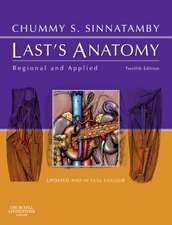A Guide to Dissection of the Human Body
Autor F. P. Lisowski, Frederick Peter Lisowskien Limba Engleză Hardback – 30 noi 1998
| Toate formatele și edițiile | Preț | Express |
|---|---|---|
| Paperback (1) | 337.69 lei 6-8 săpt. | |
| World Scientific / S'Pore Univ Press (Pte) Lt – 30 noi 1998 | 337.69 lei 6-8 săpt. | |
| Hardback (1) | 690.18 lei 6-8 săpt. | |
| World Scientific / S'Pore Univ Press (Pte) Lt – 30 noi 1998 | 690.18 lei 6-8 săpt. |
Preț: 690.18 lei
Preț vechi: 726.50 lei
-5% Nou
Puncte Express: 1035
Preț estimativ în valută:
132.08€ • 137.06$ • 110.40£
132.08€ • 137.06$ • 110.40£
Carte tipărită la comandă
Livrare economică 15-29 martie
Preluare comenzi: 021 569.72.76
Specificații
ISBN-13: 9789810235284
ISBN-10: 9810235283
Pagini: 432
Dimensiuni: 316 x 228 x 28 mm
Greutate: 0.72 kg
Ediția:1
Editura: World Scientific / S'Pore Univ Press (Pte) Lt
ISBN-10: 9810235283
Pagini: 432
Dimensiuni: 316 x 228 x 28 mm
Greutate: 0.72 kg
Ediția:1
Editura: World Scientific / S'Pore Univ Press (Pte) Lt
Cuprins
Upper limb: pectoral region and axilla; front of arm and cubital region; superficial dissection of back of trunk, scapular region and back of arm; joints of the shoulder region; front of forearm and hand; joints of free upper limb. Lower limb: anterior and medial aspects of the thigh; gluteal region and posterior aspect of the thigh; hip joint, popliteal fossa and back of the leg; anterior and lateral aspects of the leg and dorsum of the foot and the knee joint; sole of foot; tibiofibular joints, ankle joint and joints of the foot. Thorax: thoracic walls and lungs; superior and middle mediastinum; superior and posterior mediastinum and joints of thorax. Abdomen: anterior abdominal wall and external genitalia; abdominal cavity, stomach and intestines; liver, pancreas, duodenum and spleen; kidney, suprarenal and posterior abdominal wall; pelvic viscera; blood vessels, nerves and muscles of the pelvis; perineum. Head and neck: posterior triangle of the neck; anterior triangle of the neck; face and scalp; cranial cavity; orbit and lacrimal apparatus; the eyeball; parotid and infratemporal regions and temporomandibular joint; submandibular region and deep dissection of the neck; deep structures of the back of the neck and the trunk; nasal cavity; oral cavity; soft palate and pharynx; the larynx; the ear.






